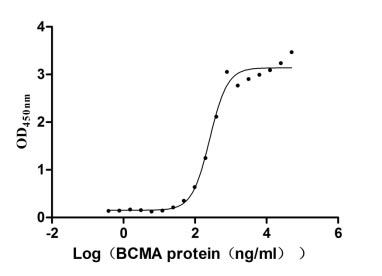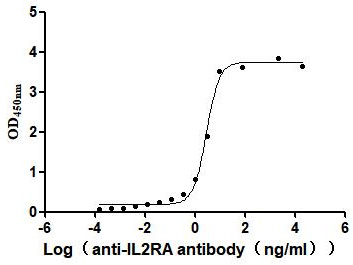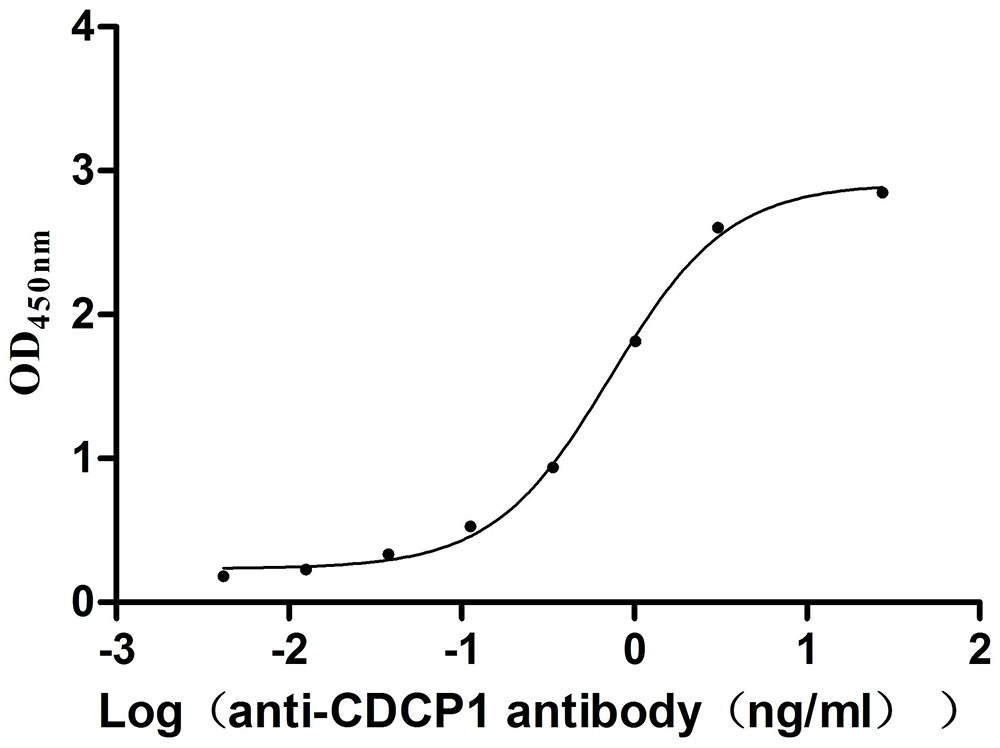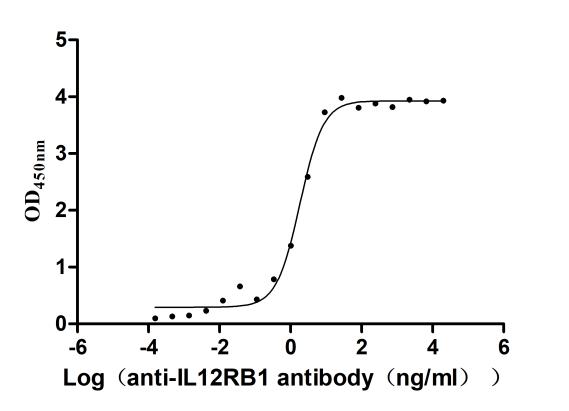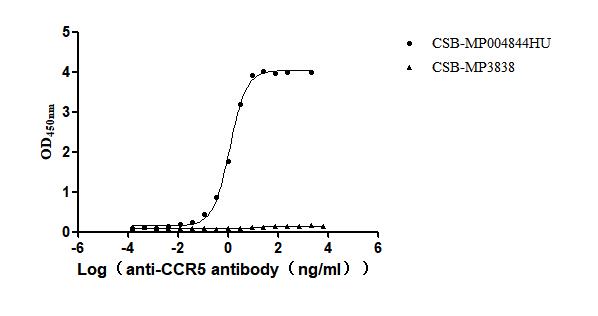Recombinant Mouse Transcription factor AP-2-beta (Tfap2b)
-
中文名稱(chēng):小鼠Tfap2b重組蛋白
-
貨號(hào):CSB-YP733781MO
-
說(shuō)明書(shū):
-
規(guī)格:
-
來(lái)源:Yeast
-
其他:
-
中文名稱(chēng):小鼠Tfap2b重組蛋白
-
貨號(hào):CSB-EP733781MO
-
說(shuō)明書(shū):
-
規(guī)格:
-
來(lái)源:E.coli
-
其他:
-
中文名稱(chēng):小鼠Tfap2b重組蛋白
-
貨號(hào):CSB-EP733781MO-B
-
說(shuō)明書(shū):
-
規(guī)格:
-
來(lái)源:E.coli
-
共軛:Avi-tag Biotinylated
E. coli biotin ligase (BirA) is highly specific in covalently attaching biotin to the 15 amino acid AviTag peptide. This recombinant protein was biotinylated in vivo by AviTag-BirA technology, which method is BriA catalyzes amide linkage between the biotin and the specific lysine of the AviTag.
-
其他:
-
中文名稱(chēng):小鼠Tfap2b重組蛋白
-
貨號(hào):CSB-BP733781MO
-
說(shuō)明書(shū):
-
規(guī)格:
-
來(lái)源:Baculovirus
-
其他:
產(chǎn)品詳情
-
純度:>85% (SDS-PAGE)
-
基因名:Tfap2b
-
Uniprot No.:
-
別名:Tfap2b; Tcfap2bTranscription factor AP-2-beta; AP2-beta; Activating enhancer-binding protein 2-beta
-
種屬:Mus musculus (Mouse)
-
蛋白長(zhǎng)度:full length protein
-
表達(dá)區(qū)域:1-459
-
氨基酸序列MHSPPRDQAA IMLWKLVENV KYEDIYEDRH DGVPSHSSRL SQLGSVSQGP YSSAPPLSHT PSSDFQPPYF PPPYQPLPYH QSQDPYSHVN DPYSLNPLHQ PQQHPWGQRQ RQEVGSEAGS LLPQPRAALP QLSGLDPRRD YHSVRRPDVL LHSAHHGLDA GMGDSLSLHG LGHPGMEDVQ SVEDANNSGM NLLDQSVIKK VPVPPKSVTS LMMNKDGFLG GMSVNTGEVF CSVPGRLSLL SSTSKYKVTV GEVQRRLSPP ECLNASLLGG VLRRAKSKNG GRSLRERLEK IGLNLPAGRR KAANVTLLTS LVEGEAVHLA RDFGYICETE FPAKAVSEYL NRQHTDPSDL HSRKNMLLAT KQLCKEFTDL LAQDRTPIGN SRPSPILEPG IQSCLTHFSL ITHGFGAPAI CAALTALQNY LTEALKGMDK MFLNNTTNRH TSGEGPGSKT GDKEEKHRK
-
蛋白標(biāo)簽:Tag?type?will?be?determined?during?the?manufacturing?process.
The tag type will be determined during production process. If you have specified tag type, please tell us and we will develop the specified tag preferentially. -
產(chǎn)品提供形式:Lyophilized powder
Note: We will preferentially ship the format that we have in stock, however, if you have any special requirement for the format, please remark your requirement when placing the order, we will prepare according to your demand. -
復(fù)溶:We recommend that this vial be briefly centrifuged prior to opening to bring the contents to the bottom. Please reconstitute protein in deionized sterile water to a concentration of 0.1-1.0 mg/mL.We recommend to add 5-50% of glycerol (final concentration) and aliquot for long-term storage at -20℃/-80℃. Our default final concentration of glycerol is 50%. Customers could use it as reference.
-
儲(chǔ)存條件:Store at -20°C/-80°C upon receipt, aliquoting is necessary for mutiple use. Avoid repeated freeze-thaw cycles.
-
保質(zhì)期:The shelf life is related to many factors, storage state, buffer ingredients, storage temperature and the stability of the protein itself.
Generally, the shelf life of liquid form is 6 months at -20°C/-80°C. The shelf life of lyophilized form is 12 months at -20°C/-80°C. -
貨期:Delivery time may differ from different purchasing way or location, please kindly consult your local distributors for specific delivery time.Note: All of our proteins are default shipped with normal blue ice packs, if you request to ship with dry ice, please communicate with us in advance and extra fees will be charged.
-
注意事項(xiàng):Repeated freezing and thawing is not recommended. Store working aliquots at 4°C for up to one week.
-
Datasheet :Please contact us to get it.
靶點(diǎn)詳情
-
功能:Sequence-specific DNA-binding protein that interacts with inducible viral and cellular enhancer elements to regulate transcription of selected genes. AP-2 factors bind to the consensus sequence 5'-GCCNNNGGC-3' and activate genes involved in a large spectrum of important biological functions including proper eye, face, body wall, limb and neural tube development. They also suppress a number of genes including MCAM/MUC18, C/EBP alpha and MYC. AP-2-beta appears to be required for normal face and limb development and for proper terminal differentiation and function of renal tubular epithelia.
-
基因功能參考文獻(xiàn):
- AP-2beta is required in the periocular mesenchyme for normal development of the anterior segment of the eye. PMID: 27483349
- AP-2 beta and beta-catenin interact both in vitro through GST pull-down assays and in vivo by co-immunoprecipitation. We further identified the interaction regions to the DNA-binding domain of AP-2 beta and the 1-9 Armadillo repeats of beta-catenin. PMID: 28277615
- Tfap2b is associated with the development and remodeling of mouse ductus arteriosus and limb patterning. PMID: 21829553
- PKD is thus a common modulator of the DNA binding activity of AP-2alpha and AP-2beta through their phosphorylation for negative regulation of the ABCA1 and adiponectin genes expression, respectively. PMID: 21345437
- postprandial activation of PKCmicro plays a role in disordered postprandial adipocytokine expression through AP-2beta. PMID: 21424113
- Data suggest that AP-2beta plays critical roles in the epinephrine phenotype and maturation of adrenal chromaffin cells. PMID: 20875861
- Tfap2beta, Et-1, and Hif2alpha act in a transcriptional network during ductal smooth muscle development. Disruption of this pathway may contribute to patent ductus arteriosus by affecting development of smooth muscle in the ductus arteriosus. PMID: 18635823
- AP-2beta transcriptional factor is a unique regulator of IRS-1 and a candidate gene for insulin resistance. PMID: 20097161
- AP-2beta might modulate the expression of adiponectin by directly inhibiting its transcriptional activity PMID: 16954217
- Hlxb9 and Tcfap2b were identified as genes whose expression was elevated in the ZPA compared to the rest of the developing limb bud. PMID: 17911046
- AP-2beta is a candidate gene for producing adipocyte hypertrophy and may relate to the abnormal characteristics of adipocytes observed in obesity. PMID: 16373417
顯示更多
收起更多
-
亞細(xì)胞定位:Nucleus.
-
蛋白家族:AP-2 family
-
數(shù)據(jù)庫(kù)鏈接:
Most popular with customers
-
Recombinant Human Tumor necrosis factor ligand superfamily member 13B (TNFSF13B), partial (Active)
Express system: Mammalian cell
Species: Homo sapiens (Human)
-
Express system: Mammalian cell
Species: Macaca fascicularis (Crab-eating macaque) (Cynomolgus monkey)
-
Recombinant Human Interleukin-2 receptor subunit alpha (IL2RA), partial (Active)
Express system: Mammalian cell
Species: Homo sapiens (Human)
-
Recombinant Mouse CUB domain-containing protein 1 (Cdcp1), partial (Active)
Express system: Mammalian cell
Species: Mus musculus (Mouse)
-
Recombinant Human Interleukin-12 receptor subunit beta-1(IL12RB1),partial (Active)
Express system: Mammalian cell
Species: Homo sapiens (Human)
-
Recombinant Human C-C chemokine receptor type 5 (CCR5)-VLPs (Active)
Express system: Mammalian cell
Species: Homo sapiens (Human)


